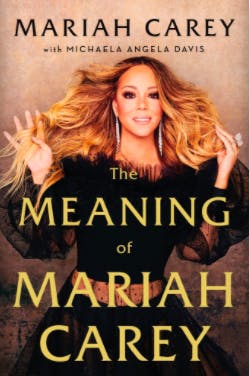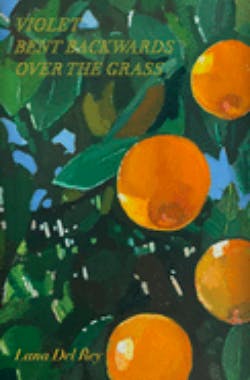The first time Mariah Carey sang on television in her whistle register—the very tippy-top of the human vocal range, higher than a falsetto—was during a performance of “America the Beautiful” at Game One of the 1990 NBA finals, around the time she released her first single, “Vision of Love.” When a singer sings this high, the epiglottis closes over the larynx, making the mechanics impossible to film with a medical camera and therefore beyond scientific study. The sound is a little otherworldly, and no one in the arena was really prepared for what came out of the skinny girl in a black dress introduced as “Columbia recording artist Mariah Carey.”
When Carey vaults up to a top C, the camera cuts to a couple of Detroit Pistons laughing and grasping each other’s forearms in shock. Mariah’s face breaks into a smile as the song ends, her dark eyes full of triumph. As she recalls in her new memoir, The Meaning of Mariah Carey, “None of the players, none of the fans knew who I was when I walked in, but they would remember me when I walked out.”

The book’s release comes as part of a broader celebration of Carey’s 30 years as a famous singer dubbed “MC30,” which has also included a lost-gems album, The Rarities; a drip feed of old remixes; and the revelation that Carey recorded a grunge album in the 1990s. The Meaning of Mariah Carey feels pieced together from interviews, so it’s not a work whose style you can delight in at the sentence level. But the story it tells feels genuine and timely. Mariah Carey has become one of the most enduring stars of our time, laying the blueprint for a generation of young singers, but her massive celebrity and commercial success have, ironically, meant that she hasn’t always been taken seriously as a songwriter. It’s a direct side effect of her success, and a trap that ensnares new artists to this day.
She’s too gracious to acknowledge her critics in the book, but the story of Carey’s childhood is an implicit riposte to the idea that she’s not an “authentic” musician. In truth, she has been an industrious vocalist with perfectionist tendencies since childhood. Singing was a connection to her mother, an Irish, Juilliard-trained opera singer who married a Black military man she was deeply incompatible with. Carey recalls in the book the moment when, at “maybe three years old,” she corrected, in perfect Italian, her mother’s rehearsal of an aria from Rigoletto.
But if her mother immersed her in the world of music, she never combed her daughter’s hair and often left her unfed. Amid her older brother throwing furniture, her mother’s neglect, and her neighbors’ racism, music became a comfort: “I was always so scared as a little girl, and music was my escape.” She describes her Long Island home as “heavy, weighed down with yelling and chaos.” The whisper-voice that Carey increasingly used during her turn to hip-hop and R&B in the later 1990s has its roots in this pain: “When I sang, in a whispery tone,” she writes, “it calmed me down. I discovered a quiet, soft, light place inside my voice—a vibration in me that brought me sweet relief. My whisper-singing was my secret lullaby to myself.”
Carey’s teen years combined a tall boyfriend (to defend her from bullies), physical hunger, and a fanatical devotion to building her craft as a singer, songwriter, and producer. Her efforts culminated in the whirlwind success of her debut album, Mariah Carey, following that basketball game and an astounding performance on Arsenio Hall. She wrote the entire album and co-produced it.
The culture’s reaction to Carey’s undeniable whistle-voice (best exemplified in another Arsenio Hall performance, this time of 1991’s “Emotions”) was double: The dollar signs flashed in the music industry’s eyes, but the critics assumed she was a corporate puppet whose Olympic-talent voice was devoid of soul. With her voice, youth, songwriting ability, and the backing of Sony executive and future husband Tommy Mottola (they met at a party, Carey writes: “Tommy said to Brenda, ‘Who’s your friend?’—the most intense three words I’d ever heard”), she seemed almost too primed for success, as if her abilities were somehow an unfair genetic advantage rather than the product of an intense emotional engagement with singing stretching back to her infancy.
In her review of Carey’s third album, Music Box, for The New York Times in 1993, Deborah Frost wrote that Carey’s “career has been chiefly remarkable for its packaging.” Though she acknowledges that Carey wrote and co-produced most of the record, Frost then writes that “the power she wields in the studio is at odds with the message of submissiveness now manifest in her songs.” She cited the lyrics to “Now That I Know”—“Now that I know you want me for me / I can be what you want”—as proof that Carey was not really in control. Even John Pareles’s rave for her Unplugged album of the same year took issue with Carey’s perfection. “On albums, Ms. Carey’s singing often sounds narcissistic,” Pareles wrote, “as if she has to cram every phrase with virtuosity.”
This level of judgment is just one sharp edge of the same knife we still apply to female musicians. It’s a feature of the business that women musicians have to be celebrities, and their haircuts and relationships and outfits become fair game once a record is released. The celebrity must engage in the tense push-pull of today’s reactive, socially driven media, because otherwise nobody will listen to their music. And then they are criticized for playing the game at all.
Because we treat women musicians as celebrities first and foremost, we require an impossible standard of integration between their art and their identity as a human being. In Carey’s case, she was able to fuse the two on her own terms, dramatizing her escape from the abusive Mottola in the emancipation-themed video for “Honey” in 1997, which commemorated Carey’s new identity as a sexy, independent musician with an agenda to push at the place where hip-hop and R&B met.
It’s a mark of progress, perhaps, that the relationship between fantasy, gender, and music is also the subject of Lana Del Rey’s debut poetry collection, Violet Bent Backwards Over the Grass. It’s already available as a spoken-word, musically accompanied album, and will be available as a book in October.

The audiobook is a 14-track, Beat-style soundscape filled by Del Rey’s breathy voice, and is very much a part of the universe styled by her seven albums to date. Los Angeles, love, and misunderstood femininity are among her themes. In “L.A. Who Am I to Love You,” she describes L.A. as “not quite the city who sleeps / Not quite the city who wakes, / But the city who dreams.” Speaking to an unknowable “you,” Del Rey establishes a beseeching style of address whose object is at various stages the listener, the city, the lover, the universe, and the self. In the second poem, “Land of 1000 Fires” she reworks that theme of California’s landscape as the literal space of her gender: “My feet aren’t even on the ground,” she writes, “I need your body to stand on / Your name to define me,” turning the co-dependency of heterosexual romance into a dangerously flammable terrain.
It’s in a bitter poem called “Salamander” that Del Rey’s book connects to Carey’s. She recites the lines in urgent, plaintive tones in the audiobook:
You see I’m a real poet
My life is my poetry
My lovemaking is my legacy
My thoughts are not for sale
They’re about nothing
and beautiful and for free
It seems like a contradiction in terms, at first, to declare oneself a poet who has nothing in their head, or to frame something as fleeting as “lovemaking” a “legacy.” But it’s actually a very good self-portrait of her music: Del Rey sings about doomed love and pretty dresses and other old clichés, but it’s the way she does it that makes her an artist. The form of her thoughts is musical, and beautiful, and made only more beautiful because they are about nothingness: specifically, the void that Hollywood distracts us from with stage makeup and artificial sets, which of course have their own beauty.
Del Rey has been accused of “inauthenticity” from the beginning of her career, just like Carey. In 2012, Paul Harris published a feature in The Guardian styled as an investigation into the true identity of Lana Del Rey. “You can still find traces of Lizzy Grant online,” it says, referring to LDR’s given name, noting that there exists video footage of the singer with—horror—blonde hair, wearing a green T-shirt. After presenting his findings, Harris concludes that the internet has “allowed figures like her to come rapidly to the fore of the cultural landscape, whether or not their emergence is planned by a record executive or happens spontaneously from someone’s bedroom.” He weakly notes that the situation seems unfair, but the existence of his investigative article rather gives the game away.
It’s exactly the point that Deborah Frost missed in her Music Box review, when she treated as mutually exclusive possibilities Mariah Carey as a soulful and autonomous artist and Mariah Carey as a popular singer of love songs. Whether drawing on new inspiration or old memories, these two singers use their books to circle the same subject: the relationship between the economy of female celebrity and the woman musician’s privately inspired work. The ultimate lesson is that the only way forward is, as in so many cases, more work.
